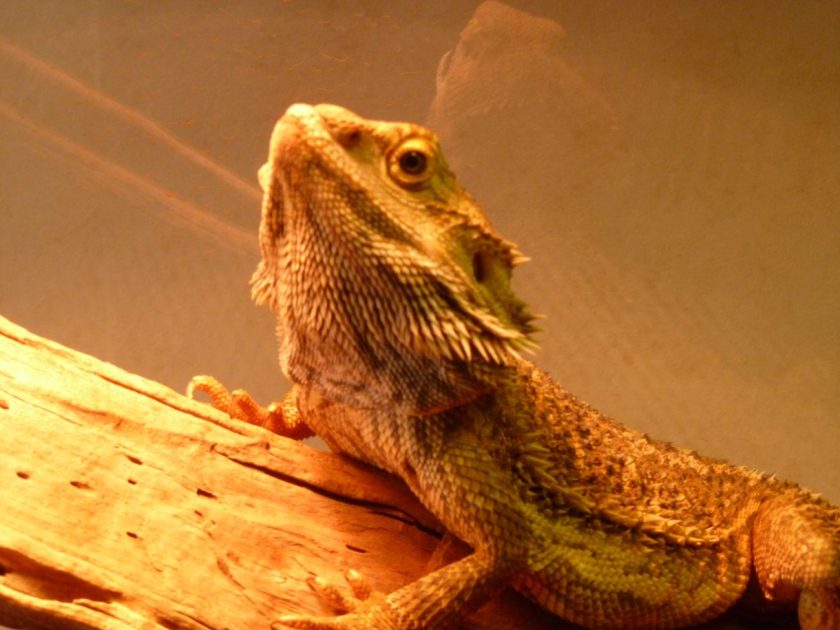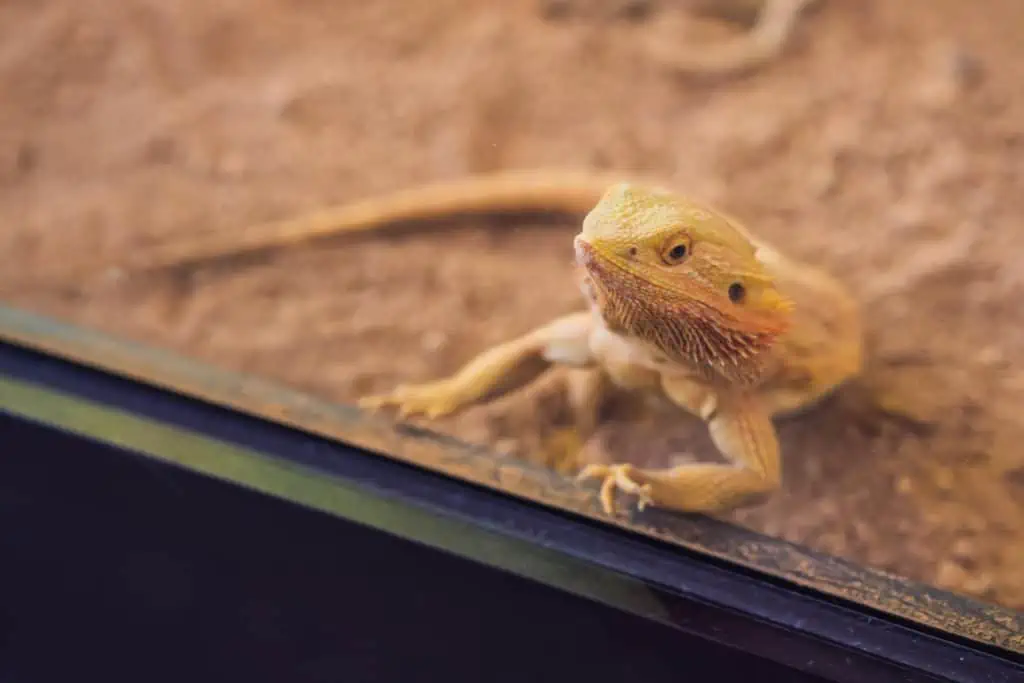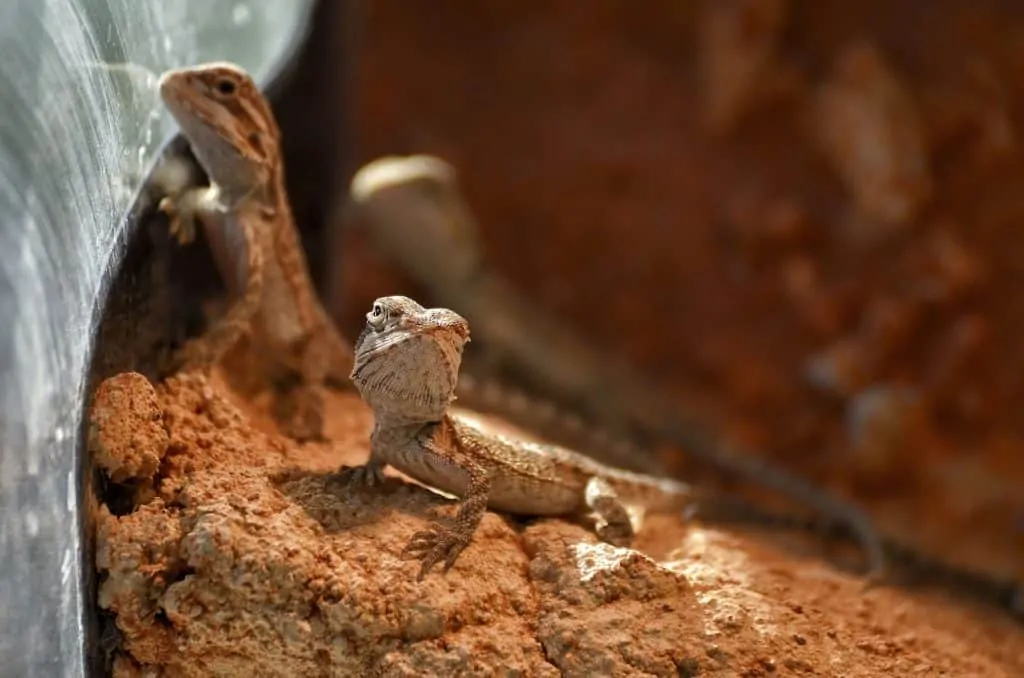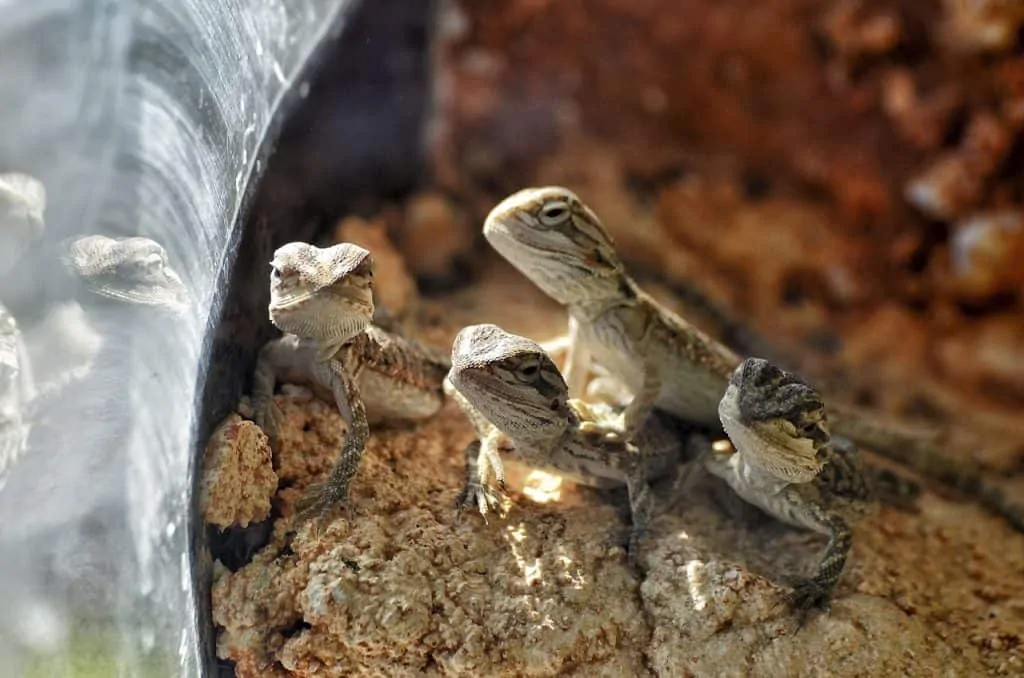Have you ever seen your bearded dragon frantically trying to scale the glass side of its enclosure? You may see it standing on its hind legs and rapidly paddling its front legs as it tries to catch a foothold. This behavior is known as glass surfing. It may seem comical, but it may be a reason for concern.
Beardie owners propose many theories about why some bearded dragons engage in this behavior. Unfortunately, there is little if any, scientific resources to explain it. Despite this, there is agreement as to what underlies these theories, which is stress.
Here, you will learn about glass surfing, what you can do to stop it, and how to prevent it from happening in the future.
What Is Glass Surfing in Bearded Dragons?
As mentioned, some bearded dragons frantically try climbing their enclosure’s glass. They may be seen standing on their hind legs and moving their front legs as though trying to escape.
There are many possible reasons for this behavior. Some of the theories proposed by beardie owners as to why bearded dragons do this include things like:
- Their enclosure is too small.
- The temperature of the enclosure is wrong.
- Boredom
- Hunger
The challenge with many of these theories is that they are anthropomorphic. Anthropomorphic means attributing human qualities to animals. The challenge is that animals do not always do things for the same reasons we do.
It may not be easy to figure out why bearded dragons glass surf as there are many possible reasons for this behavior. Despite this, there is something that you can do to help your pet. I say this because most Beardie owners agree that glass surfing is a stress reaction.
By doing some detective work, it is possible to figure out what is creating the stress in your pet. The clues that you are looking for are in the way that you are keeping your bearded dragon. You may stumble across the answer by paying attention to your husbandry practices.
Should I Be Concerned if My Bearded Dragon Glass Surfs?
The actual behavior of glass surfing is harmless. However, the cause of glass surfing may not be. Reviewing your husbandry practices to ensure you meet your pet’s needs is important. If your bearded dragon is healthy and doing well, I would not worry about your pet glass surfing.
How To Stop Glass Surfing in Bearded Dragons
The way to stop glass surfing is to review your approach to husbandry care. By making the needed corrections, you may be able to remove the source of stress for your bearded dragon.
It is important to check what is happening with your pet’s home. Does it meet your bearded dragon’s needs? Things to consider are:
Enclosure Size
Bearded dragons may feel stressed if their enclosure is not big enough. A 20-50-gallon aquarium is good for babies and juvenile bearded dragons, while an adult should be kept in a 70-gallon aquarium or larger.
Additionally, bearded dragons enjoy climbing. For this reason, provide vertical space for your pet. You can do this by furnishing the aquarium with branches, rocks, or other decorations to climb on.
New Enclosures
Bearded dragons are creatures of habit. Like us, they feel safe with what is familiar to them. If you put your beardie in a new enclosure, it may take time for them to get used to it. Glass surfing may be a sign that they have not adjusted yet to their new home.
If you need to switch your bearded dragon to a new enclosure, try to make the new tank as similar to the current enclosure as possible.
Making Changes to the Enclosure
Making rearrangements in your bearded dragon’s enclosure can be as stressful as putting it in a new enclosure. You can minimize stress on your pet by slowly changing the enclosure. You can do this by making one change at a time. Doing this will make it easier for your beardie to get used to the changes.
Temperature
Bearded dragons need to be provided with a temperature range (thermogradient). Part of their enclosure should be kept between 90-100 degrees Fahrenheit (32-38 degrees Celsius).
The cooler part of the enclosure should be between 75-80 degrees Fahrenheit (24-27 degrees Celsius). A thermogradient will allow your pet to find the temperature it needs to be comfortable.
The following are appropriate heat sources for bearded dragons:
- 100-watt incandescent bulb installed in a reflector hood.
- Reptile heating pads
- Radiant heat bulbs
- Ceramic heating elements
Place the heating sources outside the enclosure to avoid your pet burning itself. Do not use “sizzle rocks” or “hot rocks.” They are ineffective and have been known to cause burns.
Lighting
Bearded dragons need ultraviolet (UV) lighting to produce vitamin D3. The lack of proper lighting can lead them to develop metabolic bone disease. Provide your beardie with UV-B in the range of 290-320 nanometers.
Providing UV-A lightning in the 320-400 nanometers range is also important.
For the lightening to be effective, it must be 6-18 inches above the basking area.
Substrate
Use a bearded dragon substrate that is simple to clean and non-toxic. Beardies may ingest substrate while eating. For this reason, using a substrate that is made of paper is recommended. Examples of this include:
- Butcher paper
- Compressed recycled paper pellets
- Newspaper
Other alternatives include:
- Vinyl floor tiles
- Excavator Clay
Spot-clean the substrate daily and completely replace it weekly.
Do not use the following:
- Sand
- Gravel
- Wood shavings
- Walnut shells
- Cedarwood
- Calci-sand
- Cat litter
These forms of substrates are toxic or can cause problems if ingested.
Hides
Reptiles need to have a place to hide where they can feel secure. You can purchase pre-made hides at a reptile shop or create your own using objects like a cardboard box or clay pot.
Reflections
Bearded dragons are very territorial, especially the males. Seeing another beardie can cause them to become frantic. There is a theory that glass surfing may be caused by your pet seeing its reflection in the aquarium glass.
To test this theory, get construction paper and tape it to cover a four-inch area around the tank’s perimeter, just above the substrate. Additionally, you can purchase aquarium backdrops at most tropical fish stores.
Roommates
Does your bearded dragon have a roommate? If so, it may be what is causing your pet to be stressed. As mentioned before, bearded dragons are very territorial, especially males. If you intend to keep beardies together, ensure there is only one male.
How to Prevent Glass Surfing in Bearded Dragons
Can glass surfing be prevented? Absolutely! Remember, glass surfing is a sign of stress. It is a sign that something is off in your approach to care. This article addressed a range of factors that led to this behavior.
One of the major factors to consider is enclosure size. While we have addressed this already, it is worthwhile to take a closer look. Large enclosures promote natural behavior, while small ones can lead to behavior issues, including:
- Poor appetite
- Repetitive movements
- Rostral damage (rubbing snout against glass)
- Glass surfing
Additionally, small enclosures are more difficult to keep clean and to establish a thermal gradient.
When selecting an enclosure, getting the largest one possible will be worth your money. This is even true if it is a baby beardie. A well-cared-for bearded dragon will grow fast. Getting a large enclosure at the start will save you money.
Take Care!
We hope that you enjoyed this article. As you can see, glass surfing can be a gift in disguise if it leads you to discover how to improve your bearded dragon’s husbandry care. Following this article’s suggestions will make your bearded dragon a happier lizard. We welcome your comments, and please share this article.





